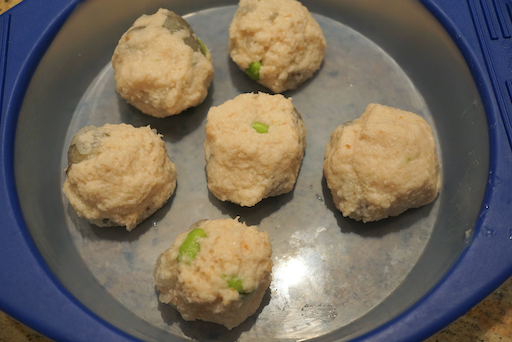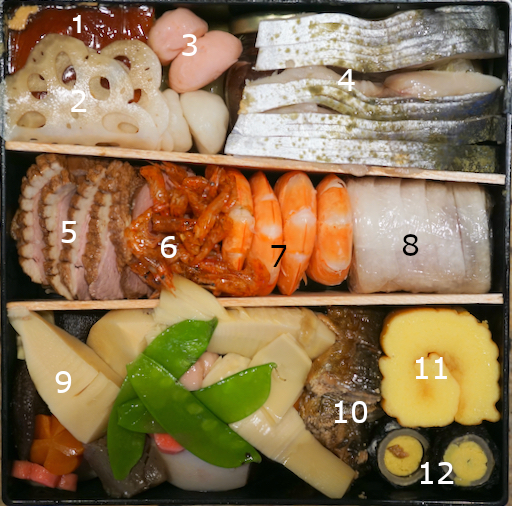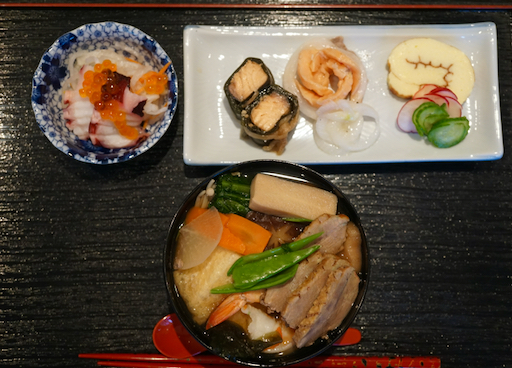Two years ago I made green tea and black bean cake using the left-over "kuromame" 黒豆 black beans in syrup that came in the Sushi Taro osechi box. The recipe I used is in English in our blog. This year I commissioned my wife to take over making the green tea cake. Then, she pointed out that we were out of "matcha" 抹茶 green tea powder. I kept it in the freezer and mostly used it for cooking such as making "green tea salt" for tempura and apparently didn’t replace it after using it up. Since we are not physically going to our Japanese grocery store because of covid, I decided to get the green tea on line. Hibiki-an 響庵 is a company we have used in the past to get green tea and we could have gotten matcha from them but it is shipped directly from Japan and would have taken too long to get here. I then found "Matcha Kari" which imports its matcha stock from Japan but is located here so delivery time was much shorter. I bought a mid-priced tea from them called "First harvest sipping matcha". (According to Mach-kari’s, Hibiki-an’s, and other websites which sell matcha, they offer several grades of matcha which appear to range from lowest quality/lowest price to highest quality/highest price, identified as “culinary”, “sipping”, “ceremonial” and “competition”.) (Disclaimer: I am not sure if there is official grading of matcha and if so what the grades would be). While we were waiting for this to arrive, I happened to see, while picking up a take-out at Tako Grill, that they had the matcha tea brand we used to get from our Japanese grocery store. This was very reasonably priced ($0.28 per gram, while the one from Matcha Kari was $1.17 per gram or over 4 times more expensive). I assume that the one from Tako Grill was not as low-grade as “culinary” matcha according to the lexicon I outlined but would be at the lower end of “sipping“ grade. It also came from “Uji” 宇治 near Kyoto 京都. We have gotten regular Uji green tea (sencha 煎茶) from Hibiki-an in the past and it was pretty good. So as far as I was concerned this matcha (left in the picture below) was certainly good enough to make green tea cake. Then, a few days later we received the matcha from "matcha kari".
Sunday, January 31, 2021
Matcha green tea tasting 抹茶の飲み比べ
Thursday, January 28, 2021
NOT "no-knead" Pecan raisin bread 捏ねないのではないピーカン、レイズンパン
I was duped into baking this bread by my wife. She found this bread recipe in a King-Authur flour catalog and ripped out the page. Since I mentioned in the previous blog that "When it comes to baking bread, I am in the school of the simpler the better like no-knead breads", my wife handed me this recipe, saying ‘here is another no-knead bread recipe you might want to try’. She even made the biga starter for me the night before. So next morning, after closely reading the recipe, I pointed out that the recipe called for kneading the bread, (multiple times), indicating to me that this was not “no knead” bread. (I have no idea why she thought this was a no-knead bread). (Note from Wifey: She has no idea why either). But by then, with the biga already made and ready to go, I did not have any choice but to make the bread. The original recipe called for dried apricots and cranberries but my wife said "just use raisins instead". (In her book, any candied or dried fruit can be substituted with raisins). So I followed her instructions. Actually the recipe requires lots of kneading, raising, deflating and raising etc. This is definitely more my wife's style bread than mine. But since I started it, I finished it.
Ingredients:
Biga (starter):
1 cup (120g) AP flour
1/4 cup (26g) Pumpernickel flour
1/2 cup (113g) water (my wife likes to use buttermilk instead)
1/8 tsp instant yeast
all of the biga
3/4 cup (170g) water
2 1/4 cup (270g) AP flour
1 1/2 tsp salt
1/2 tsp instant yeast
1/2 cup (64g) diced dried apricots
1/4 cup (28g) dried cranberries (I used about 1/2 cup of raisin instead).
3/4 cup (85g) chopped, toasted pecans.
The original recipe calls for egg wash which I skipped.
The instructions were not very precise, to say the least, and I had to use my CCK (common culinary knowledge) to fill in the “blanks”.
For the biga:
Mix all ingredients and cover and let it ferment for 12-24 hours.
For the dough (I edited for more clarity):
Mix and knead the biga, water, flour, salt and yeast (I used a stand mixer with a dough hook).
Knead in the dried fruit and the pecans.
In a bowl, put a small amount of olive oil, put in the dough ball, tuned it to coat with the oil and covered to let rise for 45 minutes.
Repeat folding and turning over the dough after 45 minutes until doubled.
Shape the dough into a ball (boule) and place in a lightly greased bowl seam-side down, cover and let it rise 45-60 minutes.
Meanwhile preheat the oven to 450F.
After 45-60 minutes (not quite doubled in bulk), brush with egg wash (I did not), slash the top (I used a lame and made a cross cut).
Bake at 450F for 15 minutes and lower the temperature to 375F and bake another 25 to 30 minutes (195F in the center of the bread).
Let it cool before slicing.
As I mentioned this is rather complicated bread to make and the original instruction was not really clear in the details. In any case, it was quite good. It was somewhat dense but moist and slightly sweet. But next time I will let my wife make it.
Monday, January 25, 2021
A spoonful appetizer 一口スプーン前菜
My wife gave me some new plates and bowls for Christmas which required us to rearrange things to make a room for them. During these activities, we found spoons my wife got for me some time ago which were meant to serve a just one-swallow/bite appetizer. Since they newly resurfaced, I promptly tried a one-swallow/bite appetizer using the spoon. The handles of the spoons are bent so that they can sit on the plate without a handle sticking over the edge. I served this with the last of New Year’s salmon kelp roll and Russian marinaded salmon.
This was quite good. Although our initial cauliflower purée was made with cauliflower cooked in milk, recently I have been making in an abbreviated quick method.
Ingredients:
One small head of cauliflower, florets separated
1-2 tbs unsalted butter
1 cup warm milk
Directions:
Steam the cauliflower using a basket steamer for 10-15 minutes until very soft.
Place the cauliflower in a plastic container for immersion blender
Add more milk for the nice silky consistency if needed.
Add the butter in thick pats
Season with salt and blend until very smooth and silky
This is wonderful way to prepare cauliflower. This purée can be used in many different ways. The smooth texture of the cauliflower purée was a great contrast to the burst of saltiness from the ikura.
Friday, January 22, 2021
Olive and black pepper savory cookies
This is part of my wife's savory cookies project. This is based on the recipe my wife found in a blog called "Raspberry Cupcake". The original recipe calls for Kalamata olives but we did not have any so she used pimento stuffed green olive instead. (Hey! They were for my Martini!).
Ingredients:
1 1/4 cup (150 gm) flour
1/4 tsp. baking soda
1/2 tsp salt
1 tsp black pepper (or to taste)
1 stick (140 gm) butter
2 Tbs. sugar
1 large egg yolk
Directions:
Measure the dry ingredients (flour, soda, salt, pepper) in a bowl and set aside. Cream the butter, sugar and egg yolk until fully incorporated and fluffy. Add the dry ingredients to the the butter egg mixture. Fold in the olives. Roll the mixture into “logs” and wrap in plastic wrap. Refrigerate the dough for at least an hour. (Dough can be refrigerated for up to week or frozen for up to a month.) To cook: preheat the oven to 350 F, slice the logs into 1/4 inch pieces and put them on a parchment covered cookie sheet. Bake for 18 to 20 minutes or until golden.
Tuesday, January 19, 2021
Steamed renkon balls 蒸し蓮根まんじゅう
This is on the theme of fresh renkon lotus root. This is another renkon ball 蓮根まんじゅう but instead of deep frying, this was steamed/microwaved (hence healthier). The original recipe calls for "ginnan" 銀杏 ginko nuts but we did not have it. So I used shelled edamame 枝豆.
Ingredients:
200 grams grated fresh renkon, skin peeled, excess moisture drained
1 tbs potato starch
4 shrimp, thawed, shelled and cut into bit size chunks
20 shelled edamame, cooked
For broth.
200 ml kelp and bonito dashi (made from dashi pack), heated
2-3 tbs shirodashi 白だし or 1tbs mirin and 1 tbs light colored soy sauce
you could thicken the broth by adding potato starch slurries (optional)
Direction:
Mix all ingredients in a bowl.
Made 6 small balls.
Using a microwave safe silicon container, I microwaved for about 2 minutes or until done.
Place one ball in a small bowl, add hot broth and garnish.
The texture is very different from the deep fried version. Much softer and gentler. We like this variation and it is easier to make. Some recipes suggest wrapping the balls in plastic wrap and microwave but I did not like the idea of microwaving in plastic wrap. That’s why I used a microwave safe silicon container instead.
Saturday, January 16, 2021
Ricotta sweet buns リコッタチーズバンズ
Ingredients:
for dough
1 cup whole milk
10 Tbs. butter melted
1 large egg plus 2 egg yolks
3 1/2 cups (496 gms) AP flour
1/3 cup (56.7 gms) sugar
2 1/4 tsp yeast
1 1/2 tsp salt
for filling
6 oz. (170 gms.) cream cheese softened
6 oz. (170 gms) ricotta cheese
3 Tbs. sugar
1 Tbs. AP flour
zest of one lemon
1/2 tsp. lemon flavoring
1 tsp. vanilla
Directions:
For the dough: Whisk milk, eggs, and butter together. Whisk flour, sugar, yeast and salt together in the bowl of a stand mixer fitted with a dough hook. Slowly add the wet ingredients to the dry ingredients until fully incorporated. Increase speed and knead for 8 to 12 minutes. Transfer to a bowl and lightly coat surface with vegetable oil. Cover and allow dough to rise until doubled.
For the filling: Cream the cream cheese with the sugar, flour, lemon zest and flavorings. Add the ricotta cheese and mix until fully combined.
Measure out the individual amount of filling to use for each muffin so the filling is distributed completely and evenly. These calculations are for this batch of bread. Each batch may have different final weights so each batch should be weighed independently. I wanted muffins that were about 50 gm size. The total dough weighed 1020 gm/ 50gm = 20 pieces. The total weight of the filling was 452 gm/20 pieces = 22.6 gm/piece. Measure out and set aside.
Assembly: After dough has risen punch down. Divide dough according to weight (in this case 50 gm) and form into rolls. Place the rolls on a parchment lined baking sheet. Allow to rise until doubled in size. Using the bottom of a glass or cup slowly press down on the center of the muffin until the cup touches the sheet. (#1 and #2). (BTW, my wife used a very special hand-made very thin-walled porcelain Japanese sake cup for this because she said the size and shape were just right. Meanwhile I held my breath hoping it would survive its application to this purpose).
Wednesday, January 13, 2021
New year's eve sashimi 2020 年越しの刺身
For New Year's eve, we started with this sashimi. I ordered Atlantic tuna toro 鮪とろ, octopus leg 蛸, and ikura イクラ (all frozen) from Catalina offshore products at least a month ahead of time because last year I waited too long and when I got around to ordering sashimi for New Year they were sold out. I also got sashimi-grade salmon but it was a large piece and would have been too much so I did not thaw it. The toro piece was small (5oz) but enough for two of us. It contained "ootro" 大トロ and small portion of "chutoro" 中トロ. The octopus legs appeared to have been imported from Japan.
Sunday, January 10, 2021
Duck leg confit 鴨足のコンフィ
Contemplating Christmas dinner, we decided we weren’t up for Turkey or ham. Then we saw a video from the Washington post regarding Duck leg confit and thought this would be perfect. We could make it ahead of time and just brown the skin before serving. Since we were getting some other meat from D'Atagnan, we ordered duck legs and rendered duck fat as well. In addition to the confit duck we served blackened Brussels sprouts and stuffing balls (without the broccoli).
Ingredients: (we cooked 4 legs)
4 duck legs (from D'Artagnan, #1 and #2)
Few sprigs of rosemary (or thyme, we used rosemary from our herb garden) (#3)
4 crushed garlic (#3)
Kosher salt
21 oz (3, 7oz containers = 21 oz.) of rendered duck fat
Directions:
In a sealable container which snugly fits 4 legs, salt the bottom, place the duck legs, salt the skin side, add the sprigs of rosemary, and crushed garlic, close the lid and refrigerate overnight (#3)
Next day, remove the rosemary and place the legs in a slow cooker and pour in the rendered duck fat to cover (#4), transfer the crushed garlic. In a low setting cook the duck legs for 3 hours with a lid on (original recipe used a 250F oven). The meat retracts from the leg bone (#5) indicating it is done. Transfer the duck fat and legs to the sealable container and refrigerate until serving (the recipe said it will keep for a few months and the flavor will improve).

Thursday, January 7, 2021
Osechi day 1 and day 2, 2021 元旦と2日の御節
This is the second plate; in the center next to the ikura is monkfish liver terrine 鮟肝豆腐 which is really good. I put wasabi and soy sauce on the red and white fishcake 紅白蒲鉾 before enjoying.
The yellow ball is soy sauce marinated egg yolk with walnut embedded in the center 黄身胡桃. The texture is really great. Next to the egg yolk on the right is "Koji-pickled Boston mackerel" 鯖麹漬. This is also a great dish with crunchy cubes of either daikon or radish.
Monday, January 4, 2021
Sushi Taro Osechi 2021 寿司太郎の御節 2021
Everything was carefully prepared and packed. All possible superlative adjectives can not begin to describe how wonderful each dish was. I do not know how many orders they prepare but I got some glimpse of how much work this is from Chef Kitayama's instagram "chefmasayakitayama" and "togimax". Our only task now is to enjoy all these delicacies, something we are very good at.
Friday, January 1, 2021
Happy New Year 2021 あけましておめでとう2021
The year 2020 was a quite taxing year. We hope things will get better in 2021, although we are, by no means, out of woods. Because of Covid, we stopped going to our Japanese grocery store (or many other stores for that matter). Having home delivery was a God-send. Nonetheless, however, we were not able to get all of our usual New Year food items or decorations including "Kagami-mochi" 鏡餅. (There may be a silver lining in this since we almost never eat all the small round mochi contained in it). So, this year our New Year's display was absent the Kagami-mochi. We only displayed the zodiac animal figurines representing the year--which in this case was the Ox. The pictures below show our collection of zodiac oxen. The smallest guy, in front, looks like a holstein cow and is made of painted wood. The one standing behind and looking at him is made from "do-rei" 土鈴 or earthenware and is actually a bell.







%20apricot%20and%20cranberry%20bread%20-%201.jpeg)

































